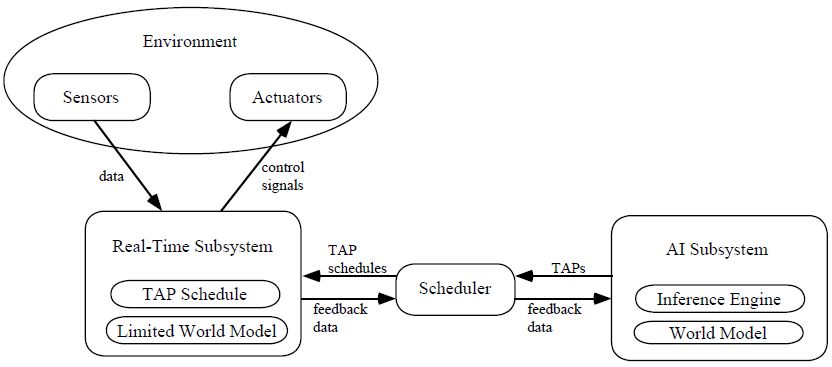 CIRCA (Cooperative Intelligent Real-time Control Architecture) was designed by David J. Musliner as his
CIRCA (Cooperative Intelligent Real-time Control Architecture) was designed by David J. Musliner as his
1993 PhD in Computer Science / Artificial Intelligence in the Department of Electrical Engineering and Computer Science, University of Michigan, Ann Arbor, MI, USA, and by the project research group at the University of Maryland Autonomous Mobile Robots Lab, to combine the benefits of AI planning with hard real-time plan execution when required.
E-mail: Этот адрес электронной почты защищён от спам-ботов. У вас должен быть включен JavaScript для просмотра. | David Musliner | CIRCA (pdf)
Архитектура CIRCA разрабатывалась Дэвидом Муслинером (David J. Musliner) в рамках его диссертация в Отделении электротехники и информатики (Department of Electrical Engineering and Computer Science) Университета штат Мичиган (University of Michigan) в Энн-Арбор, Мичиган, США и затем как часть соответствующего проекта в Лаборатории автономных мобильных роботов (Autonomous Mobile Robots Lab) Университета штата Мэрилэнд (the University of Maryland).
CIRCA Architecture is one of the first AI architectures designed specifically for hard-real-time environments and architecturally-enforced performance guarantees.
Beginning with the objective of providing reliable real-time executi on of automatically-generated plans, CIRCA research progressed to define a rigorous link between planning models, execution semantics, and performance guarantees. Formal verification techniques and automatic abstraction methods were then incorporated to improve the rigor and performance of the planning system. Multi-agent negotiation and coordination capabilities were developed to demonstrate performance guarantees spanning distributed CIRCA agents.
As the limitations of CIRCA's fully-guaranteed semantics became clear, the research grew to include probabilistic versions of the proble m and new solution methods.
Versions of CIRCA are capable of reasoning about durative concurrent actions, exogenous events and adversaries, nondeterministic actions, and prob- abilistic actions and events.
Общие сведения
Архитектура CIRCA [Musliner, Goldman, & Pelican, 2001] включает в себя статическую память для возможных действий, переходов, зависящих от времени и событий, а также динамическую память для конкретных планов и событий. Когнитивная подсистема генерирует планируемый курс действий, закодированный как граф недетерминированных конечных состояний, начиная сначала с абстрактного плана и улучшая его при необходимости. Архитектура передает эту структуру в подсистему, работающую в режиме реального времени, которая работает параллельно с когнитивной подсистемой, позволяя первой выполнять план, а второй пытаться его улучшить.
The Cooperative Intelligent Real-time Architecture (CIRCA) [Musliner et al. 1995, Goldman et al. 1997] was designed to enable real-time plan execution guarantees via careful planning and scheduling of time-critical actions that avoid system failure while achieving mission goals and to explicitly separate the time-consuming planning process from realtime plan execution.
Using this approach, the planner reasons about real-time, but does not have to make approximations that permit planning in real-time.
The cognitive subsystem generates a planned course of action, encoded as a nondeterministic finite state graph, starting first with an abstract plan and refining it as appropriate.
The architecture passes this structure to a real-time subsystem that operates in parallel with the cognitive subsystem, letting the former execute the plan while the latter attempts to improve it.

Fig. 1. Original CIRCA
As shown in Figure 1, CIRCA is divided into a planner, scheduler, and real-time [plan-execution] subsystem.
The planner first compiles a set of actions to achieve its goals while avoiding failure.
To build real-time plans, CIRCA’s planner employs a time-dependent state transition model and a representation for system “failure” such that plans contain two classes of test-action pairs (TAPs): “guaranteed” with hard deadlines for failure avoidance, and “soft real-time” with best-effort execution for goal achievementThe current versions of CIRCA use formal verification engines, including our own in-house systems and Kronos from VERIMAG (a Research Center in Embedded Systems).
The guaranteed TAP set is sent to a real-time scheduler, and when scheduling is successful, possibly after extensive planner backtracking, downloaded to the real-time subsystem for execution.
CIRCA-II Architecture
CIRCA and CIRCA-II were developed specifically to combine the benefits of AI planning with hard real-time plan execution when required.
Domain properties must be modeled with symbolic features and values, the temporal behavior of environmental events must be well characterized, and actions must have predictable worst case execution properties. As such, CIRCA-II is appropriate for autonomous vehicles that operate in a dynamic environment, such as aircraft or “on-road” automobiles.
Also, CIRCA has been demonstrated in a factory automation task [Musliner et al. 1995] from the perspective of a single robot arm.
Publications
Selected Publications
The Evolution of CIRCA, a Theory-Based AI Architecture with Real-Time Performance Guarantees. David J. Musliner, Michael J. S. Pelican, Robert P. Goldman, Kurt D. Krebsbach, Edmund H. Durfee, 2008
Musliner, D.J., Goldman, R.P., & Pelican, M.J. (2001). Planning with increasingly complex models. In Proceedings of the international conference on intelligent robots and systems.



